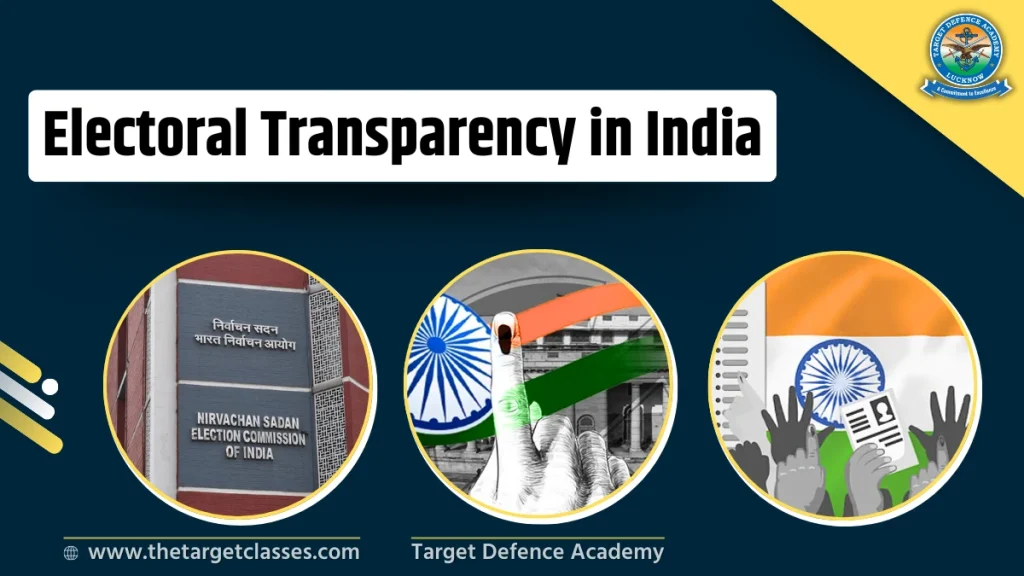Context
Recently, the Election Commission of India commenced the Special Intensive Revision of the electoral rolls of Bihar to verify 8 crore voters. This drastic step was taken without any prior public information or consultation. Lack of transparency has continued to characterise the exercise on the ground, raising concerns about the credibility of the process. Here, we have discussed in detail the Electoral Transparency in India.
Electoral Transparency
It refers to the openness, clarity, and accessibility of all processes, information, and funding related to elections. It ensures that citizens, stakeholders, and regulatory bodies can scrutinise and trust the integrity of the electoral system.

Importance of Electoral Transparency
1. Builds Public Trust and Legitimacy: When the electoral process is transparent, it instils confidence in voters, candidates, and political parties.
2. Ensures Accountability: Transparency holds election management bodies, political parties, and candidates accountable for their actions. It makes it difficult for unwanted practices to ensue.
3. Reduces Fraud and Malpractice: Open procedures and clear guidelines minimise opportunities for electoral fraud, rigging, and manipulation. When processes are transparent, fraudulent activities have no space.
4. Promotes Informed Decision-Making by Voters: It enables voters to have access to crucial information. It includes candidate backgrounds (including criminal antecedents), sources of political funding, and party manifestos. This enables them to make choices based on information and knowledge.
5. Enhances Participation: When voters perceive the electoral process as fair and transparent, they are more likely to participate actively. A sense of fairness encourages civic engagement.
6. Safeguards Fundamental Rights: Electoral transparency aligns with fundamental rights such as the right to information and the right to vote.
Various Challenges Associated with It
1. Political Funding Transparency: Unidentified donations make it harder for citizens to know who is financing political parties. So, it raises questions about any favours, arrangements or corporate influence.
2. Electronic Voting Machines (EVMs): Opposition calls them “black boxes” because voters cannot independently verify their votes, whether it was counted accurately or not.
3. Accuracy and Transparency of Electoral Rolls: Duplicate Entries, Deletion of Genuine Voters, and Aadhaar Linkage Controversy are a few issues. Also, a normal increase in the number of voters listed in the electoral rolls between the elections raises questions.
4. Transparency in the Appointment of Election Commissioners: The new Act replaced the CJI with a Union Cabinet Minister. As a result, concerns regarding the government’s majority in the selection committee potentially impact the perceived independence of the ECI.
5. Restrictive access to CCTV footage of the polling process: Conduct of Election Rules 1961 were recently amended to restrict access to CCTV footage of the polling process.
What have been the various initiatives to enhance Electoral Transparency?
1. Disclosure of Candidate’s Assets and Liabilities: The ECI mandated that all contesting candidates file an affidavit disclosing their criminal antecedents, financial assets, liabilities, and educational qualifications.
2. Supreme Court’s Ruling on Electoral Bonds: Supreme Court, in its judgment in February 2024, struck down the Electoral Bond scheme as unconstitutional. It directed the State Bank of India (SBI) to disclose all details of electoral bonds purchased and redeemed to the ECI, which then published this data.
4. Electoral Roll Management through ERO Net: It is an online platform that automates the process of electoral roll management. Its purpose is to reduce errors, check duplicate entries, and make the process more transparent and smooth.
One Nation One Election: Implementation and Background
Best NDA Coaching in Lucknow, India | Best NDA Coaching with Hostel
Download the Mobile App of Target Defence Academy
Way Forward
1. Bring Political Parties under RTI: This would enable citizens to ask for the information about their funds, including donations and expenses.
2. Lower Anonymous Donation Threshold: Reduce the threshold for anonymous cash donations, ideally to zero, or at least below the current ₹20,000. All donations should be made through traceable digital means.
3. Increased VVPAT Verification: A scientifically determined, statistically robust sample size for VVPAT counting should be adopted to ensure a higher degree of confidence in the EVM results.
4. Real-time Online Updates with Transparency: Make the electoral roll update process more dynamic, allowing for real-time online updates. Ensure that any changes in the electoral roll are published transparently and allow for public inspection and questions.
5. Publish Voter Rolls and Turnout Data Promptly: The EC should release consolidated, digital, and machine-readable electoral rolls and real-time voter turnout data for all elections.
6. Access for Observers: Ensure that domestic and international observers, as well as party agents, have unhindered access to polling and counting centres to monitor the process.
Conclusion
The responsibility lies with the Election Commission to ensure transparency in the electoral process and restore the trust of the voters robust on the process of free and fair elections. As ECI is one of the bulwarks of the constitution, it must be more responsible, transparent and accountable.


One thought on “Electoral Transparency in India”
Comments are closed.